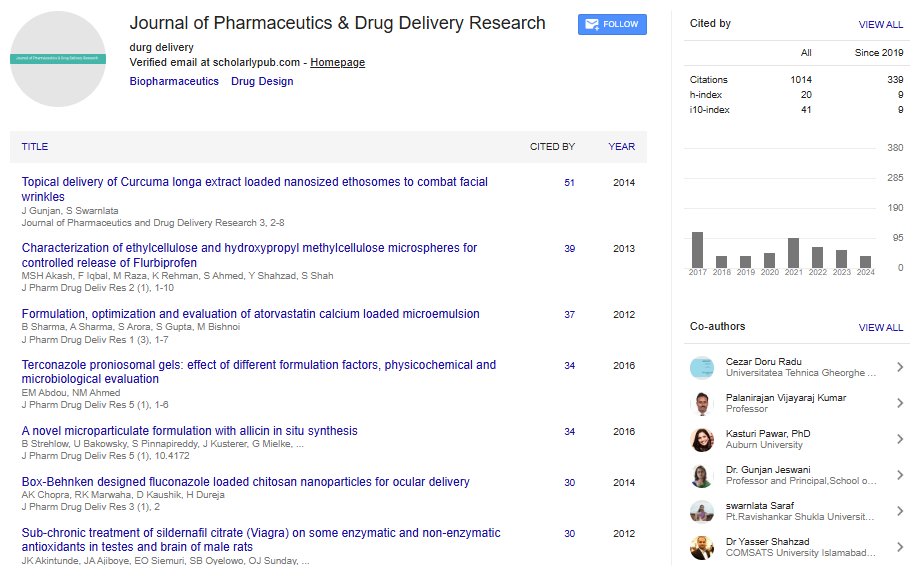Commentary, J Pharm Drug Deliv Res Vol: 13 Issue: 5
The Intricacies of Drug Design and Development: From Concept to Clinical Application
Mahmood Akbari*
1Department of Pharmacology, University of Science and Technology, Daejeon, Republic of Korea
*Corresponding Author: Mahmood Akbari,
Department of Pharmacology,
University of Science and Technology, Daejeon, Republic of Korea
E-mail: akbarim38@gmail.com
Received date: 26 August, 2024, Manuscript No. JPDDR-24-151933;
Editor assigned date: 28 August, 2024, PreQC No. JPDDR-24-151933 (PQ);
Reviewed date: 11 September, 2024, QC No. JPDDR-24-151933;
Revised date: 18 September, 2024, Manuscript No. JPDDR-24-151933 (R);
Published date: 26 September, 2024, DOI: 10.4172/2325-9604.1000299
Citation: Akbari M (2024) The Intricacies of Drug Design and Development: From Concept to Clinical Application. J Pharm Drug Deliv Res 13:5.
Description
Drug design and development are precarious steps in translating scientific discoveries into practical therapies. This process involves intricate planning, screening and optimization of chemical compounds that can impact specific biological targets. The journey from identifying a potential drug target to seeing it available in the market is long, complex and highly regulated, involving several stages from initial research to clinical trials. This article delves into the key phases of drug design and development, focusing on how scientific, regulatory and clinical considerations come together to ensure safe and effective medicines.
In drug design, the first step is identifying and validating a target typically a specific protein, gene, or receptor in the body associated with a disease. Target identification involves understanding the disease's underlying biology to identify molecules that play a precarious role in its progression. Once a target is identified, researchers validate it by determining if modifying it can affect the disease. This stage relies on bioinformatics, genomics and proteomics tools to understand the molecular basis of diseases.
After the target is confirmed, scientists search for a "lead" compound that can interact with it effectively. Lead compounds are identified through high-throughput screening of extensive chemical libraries or virtual screening using computational models. In some cases, natural products and traditional medicinal compounds serve as starting points for drug discovery. The goal is to find molecules that bind to the target and show a promising therapeutic effect without unwanted side effects.
Once a lead compound is found, it undergoes optimization to enhance its efficacy, selectivity and pharmacokinetic properties (absorption, distribution, metabolism and excretion). Optimization often involves modifying the chemical structure of the compound to improve its activity and reduce potential toxicity. Medicinal chemists collaborate closely with pharmacologists in this stage to refine the drug candidate's effectiveness and safety profile.
Before a drug can be tested in humans, it undergoes extensive preclinical studies to assess its safety and biological activity. This includes both in vitro (laboratory) and in vivo (animal) studies to evaluate the drug's toxicity, pharmacodynamics (effects on the body) and pharmacokinetics. Preclinical data are precarious for regulatory approval to proceed to clinical trials.
Clinical trials are divided into three main phases:
• Phase I focuses on evaluating safety, tolerability and optimal dosing in a small group of healthy volunteers or patients.
• Phase II trials assess the drug's efficacy and side effects in a larger patient population, helping to confirm the optimal dose and treatment regimen.
• Phase III trials involve a much larger patient population to determine the drug’s effectiveness and safety on a broader scale. Successful results from Phase III trials are required for regulatory approval.
Regulatory approval and post-market surveillance
Following successful Phase III trials, the drug’s developer submits a New Drug Application (NDA) to regulatory authorities like the Food and Drug Administration (FDA) or European Medicines Agency (EMA), including all data on the drug’s efficacy, safety and manufacturing processes. Once approved, the drug can be marketed and prescribed to patients. However, post-market surveillance (Phase IV trials) continues to monitor long-term safety and effectiveness in real-world settings, allowing for the detection of any rare adverse effects.
The drug design and development process faces numerous challenges, including high costs, long timelines and potential safety risks. However, innovations in Artificial Intelligence (AI) and Machine Learning (ML) are transforming drug discovery by enabling faster and more efficient screening of potential drug candidates. Additionally, technologies like CRISPR for gene editing and nanotechnology for targeted drug delivery are expanding the possibilities for developing highly specific and personalized treatments.
Conclusion
Drug design and development are dynamic fields that integrate biology, chemistry, pharmacology and regulatory science to bring new therapies to patients. Despite the challenges, advancements in technology and our growing understanding of disease biology are driving innovation, leading to safer, more effective treatments. As these fields evolve, they hold tremendous potential to address unmet medical needs and transform the future of medicine.
 Spanish
Spanish  Chinese
Chinese  Russian
Russian  German
German  French
French  Japanese
Japanese  Portuguese
Portuguese  Hindi
Hindi 
